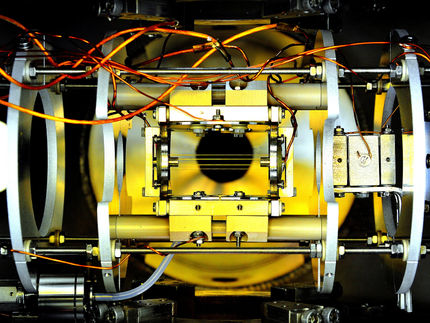Recreating interstellar ions with lasers
Trihydrogen, or H3+, has been called the molecule that made the universe, where it plays a greater role in astrochemistry than any other molecule.

MSU's Marcos Dantus has recreated interstellar ions with lasers.
Courtesy of MSU
While H3+ is astronomically abundant, no scientist understood the mechanisms that form it from organic molecules.
Until now.
Using lasers, Michigan State University scientists have unlocked the secret. In a basement laboratory on campus, Marcos Dantus, University Distinguished Professor in chemistry and physics, and his team essentially duplicated the mechanism that's found from the center of the galaxy to Earth's own ionosphere.
The scientists found H3+ when they used a strong-field laser to initiate a reaction and a second femtosecond laser to probe its progress. These interactions often lead to exotic chemical reactions. In this case, it unexpectedly revealed the phantom mechanisms of H3+.
"We found that a roaming H2 molecule is responsible for the chemical reaction, producing H3+; roaming chemistry is extremely new and little is known about it," Dantus said. "This is the first documented case for a roaming H2 reaction, which is significant because roaming mechanisms are a budding chapter of chemistry - one that may provide explanations for unlikely and unexplained chemical reactions."
One reason for the dearth of knowledge is that the process happens in near immeasurable time. The entire reaction, involving cleavage and formation of three chemical bonds, takes between 100 or 240 femtoseconds. That's less time than it takes a bullet to travel the width of an atom, Dantus added.
How the roaming H2 molecule extracts the proton to evolve to H3+ is nothing short of astounding, according to the scientists. A neutral H2 molecule is formed upon ionization of an organic molecule, and it roams around the remaining ion until it finds an acidic proton. Once targeted, it then extracts the proton, and collects it to transform into the most abundant ion in the universe.
"We were able to duplicate in our lab what's happening in the cosmos as we speak," Dantus said. "Understanding this mechanism and its timescale takes us one step closer to understanding the chemical reactions that created the building blocks of life in the universe."
Future research will focus on the effect of molecular size and structure on the likelihood and timing of roaming chemical reactions.
Original publication
Other news from the department science

Get the chemical industry in your inbox
By submitting this form you agree that LUMITOS AG will send you the newsletter(s) selected above by email. Your data will not be passed on to third parties. Your data will be stored and processed in accordance with our data protection regulations. LUMITOS may contact you by email for the purpose of advertising or market and opinion surveys. You can revoke your consent at any time without giving reasons to LUMITOS AG, Ernst-Augustin-Str. 2, 12489 Berlin, Germany or by e-mail at revoke@lumitos.com with effect for the future. In addition, each email contains a link to unsubscribe from the corresponding newsletter.





























































